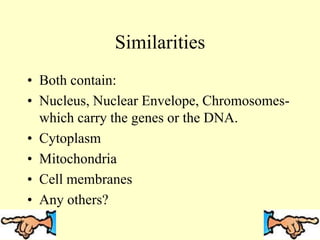1. Animal Plant Cells differences 2.ppt
- 1. The Similarities and Differences of Animal and Plant Cells Created by C. Rhein Hazelwood Central Teacher’s Page Forward
- 2. Cells • Cells are the basic units of function in all living things. • Cells in animals and plants have unique forms that allow each to take part in processes that are necessary for the cell and or/living thing to survive. Let’s take a closer look at the similarities and differences between animal and plant cells.
- 3. Explain if this is a plant or animal cell. Write down any characteristics to support your decision.
- 4. Explain if this a plant or animal cell. Write down any characteristics to support your decision.
- 5. Plant Cell
- 6. Animal cell
- 7. Now that you have seen pictures of the cells, exactly what are the organelles. • What is an organelle? • Organelles are to cells what organs are to the body. • They carry out the individual tasks of gaining and working with energy, as well as directing the overall behavior of the cells. • Let’s familiarize yourself with the organelles of the animal and plant cell.
- 8. Organelles : Function : Nucleus: Contains the DNA and RNA and manufactures proteins Nucleolus: In nuclei where ribosomes are synthesized. Nuclear Envelope: Membrane of lipids and proteins that surrounds nucleus Centrioles: structure that appears during mitosis(cell division) Mitochondria: Energy producers of the cell Ribosomes: Produce proteins More Organelles
- 9. Organelles Function Golgi Bodies: Packages Proteins Chloroplasts: Involved in photosynthesis Vacuoles: Store waste, nutrients, and water Lysosome: Contains digestive enzymes, mostly in animal cells Endoplasmic Reticulum: Passageway that transports proteins from the nucleus Rough ER covered in ribosomes, Smooth ER is not!
- 10. While not exactly organelles, the following are important parts of the cells: • Cell membrane: Semi-permeable lining that surrounds the cell • Cell Wall: Is a stiff non-living wall that surrounds the cell membrane made of cellulose • Cytoplasm: Jelly-like material surrounding the organelles
- 11. There are a few important processes in which the plant and animal cell engages: • Diffusion: How food, air, and water gets in and out of the cell. • Cellular Respiration: How an animal cell gets energy. • Photosynthesis: How a plant cell gets energy.
- 12. Animal and Plant cells have many similarities. Can you write the organelles and cell parts they both have in common.
- 13. Similarities • Both contain: • Nucleus, Nuclear Envelope, Chromosomes- which carry the genes or the DNA. • Cytoplasm • Mitochondria • Cell membranes • Any others?
- 14. Animal and plant cells are also different. Can you explain four reasons as to how plant cells are different from animal cells?
- 15. Differences • Plant cells have non-living rigid cell walls. • Plant cells contain chloroplasts which contain chlorophyll, a green chemical needed for photosynthesis. • Plant cells contain a large vacuole; animal cells never contain large vacuoles. • Plant cells are regular in shape; animal cells are irregular in shape. Back to Home Page














